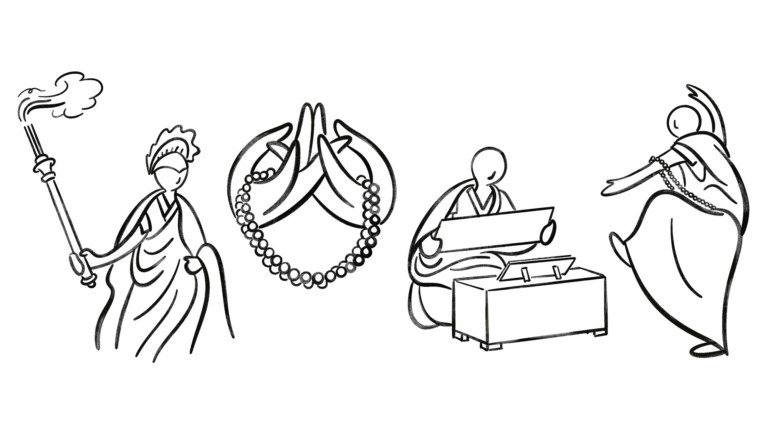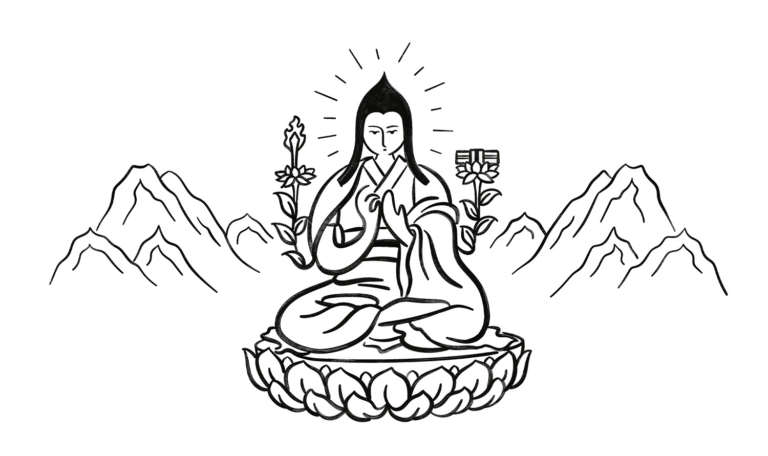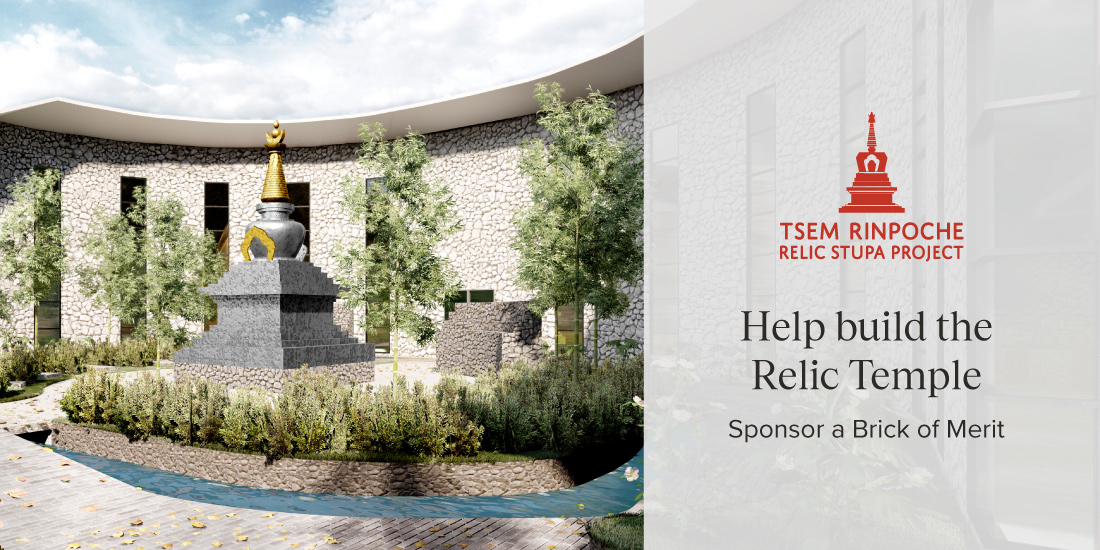Know your roots
-
Home / Our Lineage
We belong to the Gelug school of Tibetan Buddhism, which is one of the four main traditions of Tibetan Buddhism. The name “Gelug” means “virtuous tradition” and it’s the newest and largest sect of Tibetan Buddhism.
The Gelug sect was founded in the 15th century by the Buddhist scholar-saint Lama Tsongkhapa. Known as the Second Buddha, Lama Tsongkhapa mastered the Buddhist traditions of his time and combined the best of each to establish the Gelug lineage.
The origins of the Gelug school can be traced back to Buddha Shakyamuni via the Kadampa tradition of the great Indian master Atisha in the 11th century. For this reason, Gelugpa practitioners are sometimes known as new Kadampas. It’s also known as the Yellow Hat sect because of the yellow hats worn by its adherents.
Practitioners of the Gelug school or “Gelugpas” emphasise scholarship through the study and contemplation of Buddhist scriptures, and intellectual analysis through dialectical debate. There’s also a special emphasis on ethics or monastic discipline, as the ideal foundation for the practice of Sutra and Tantra.

Both lay and ordained Gelugpas are encouraged to study and practise Lojong (Mind Training) and Lamrim (Stages of the Path). Lojong is a system of practical instructions for turning adverse situations into methods for developing compassion and wisdom, while the Lamrim condenses all of Buddha’s teachings from the most basic to the most advanced into a progressive path that leads to enlightenment.
Gelugpa monastics also study the Five Major Treatises of Prajnaparamita (perfection of wisdom), Madhyamaka (middle way), Pramana (valid cognition), Abhidharma (phenomenology) and Vinaya (monastic discipline). Monks who successfully complete their studies are awarded one of the three types of geshe degree (Dorampa, Tsogrampa or Lharampa), the highest of which is equivalent to a PhD in Tibetan Buddhism. Geshes can then go on to higher tantric studies, enter long-term meditation retreat, or teach.
The main tantras practised in the Gelug tradition are Guhyasamaja, Chakrasamvara and Yamantaka, followed by Kalachakra and Vajrayogini. The head of the Gelug sect is the Gaden Tripa or Gaden Throneholder, and the main monasteries are Gaden, Sera and Drepung. We are affiliated with Gaden Monastery, which is the very first Gelug monastic university established over 600 years ago in Lhasa, Tibet.

LINEAGE FOUNDER
Lama Tsongkhapa
Lama Tsongkhapa (1357-1419) was an illustrious Buddhist scholar-saint who lived in Tibet during a time when Buddha’s teachings had degenerated. Revered as an emanation of the three great Bodhisattvas Chenrezig, Manjushri and Vajrapani, Lama Tsongkhapa embodied their respective profound qualities of enlightened compassion, wisdom and spiritual power.
Tsongkhapa means “the man from Tsongkha, the Onion Valley” and his coming was prophesied by Buddha Shakyamuni.
After I pass away and my pure doctrine is absent
You will appear as an ordinary being,
Performing the deeds of a Buddha
And establishing the Joyful Land, the great Protector,
In the Land of the Snows.
From the time of his conception, Lama Tsongkhapa’s mother had continuous dreams and auspicious signs heralding his birth. For example, she dreamt that Lord Vajrapani threw vajras from the heavens, which landed softly and gently on her womb. She had frequent dreams of Lord Manjushri appearing and casting his sword towards the direction of her womb. Just before she gave birth, she dreamt that many monks came to make offerings and were looking for the Buddha. A young boy appeared with a key which opened up a box in her womb and within was Lord Chenrezig. These were powerful portents of a very special being who was an emanation of the three great Bodhisattvas.
Lama Tsongkhapa was born on the 25th day of the 10th month in the year 1357. When he was born, his mother suffered no pain and celestial beings were heard singing outside with incredible voices. After his birth, his placenta was buried in the ground. From that exact spot, a splendid sandalwood tree sprung up with more than 100,000 leaves featuring images of the Buddha Simhananda and the mantras of Manjushri. It remains a highly revered pilgrimage site today.
At the age of three, the extraordinary child received layman’s vows from H.H. the 4th Karmapa, and novice ordination at the age of seven from his first teacher, Dhondrup Rinchen. Without being taught, he could read and write Buddhist texts, just by observing his teacher.
From a young age, he received many teachings and initiations including Heruka, Yamantaka and Hevajra. He went on to study under 45 of the greatest teachers from different Buddhist lineages. His capacity to memorise was phenomenal and his skill at debate was legendary. He mastered not just the Buddhist teachings of Sutra and Tantra, but also excelled in medicine, astrology and poetry.
Lama Tsongkhapa engaged in monumental purification retreats, of which the most famous one was when he and his eight closest disciples completed 3.5 million full-length prostrations to the 35 Confessional Buddhas and 1.8 million mandala offerings. Till this day, the imprint left behind as a result of these prostrations can be seen in his retreat cave in Tibet. At the conclusion of the retreat, he had a direct vision of Manjushri and remained in constant communion with Manjushri for the rest of his life.
Through deep study, profound practice and high attainments, Lama Tsongkhapa led a renaissance of pure Buddhist teachings by emphasising study, morality and distilling the best teachings from the existing schools of Buddhism in Tibet and from Indian Buddhist masters.
Among the many renowned teachings he gave and Dharma texts he composed, his Lamrim Chenmo, translated as The Graded Stages of the Path to Enlightenment, is considered one of his greatest works and is widely studied today, by both ordained Sangha and laypeople all over the world.
His four greatest deeds are:
- Restoring the Maitreya Statue in Dzingji Temple
- Reviving monastic discipline (Vinaya) and revitalising the tradition of monasticism in Tibet
- Establishing the Monlam Chenmo, the annual Great Prayer Festival celebrating the life and teachings of Buddha Shakyamuni
- Founding the great monastic institution of Gaden, which Kechara is affiliated to.
Despite his high attainments and enlightened qualities, Lama Tsongkhapa never exhibited any public display of miraculous powers, such as clairvoyance, and expressly prohibited his disciples from doing so. Instead, he focused on studying and teaching pure Buddhadharma, and was a role model of pure virtue. To this day, he is regarded as the Second Buddha and one of the most important figures in the history of Tibetan Buddhism.



